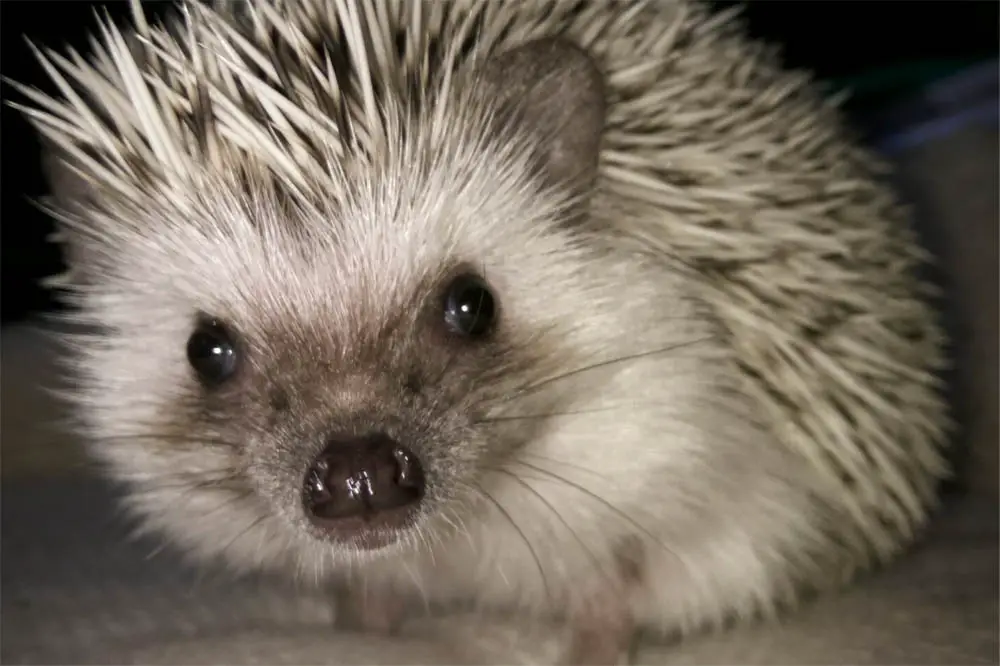The hedgehog pet craze has taken the U.S. by storm, but this cute pet – known by hedgehog lovers as “hedgies” for short – is surprisingly controversial.
Don’t get us wrong: hedgehogs make adorable pets, with their distinctive quills and innocent little faces, and they’re also relatively low maintenance to keep as pets.
However, as with owning any pet, you need to be prepared for welcoming this creature into your home, and should get acquainted with their species before doing so.

In this article, we’ll be providing you with the ultimate guide to owning a hedgehog as a pet, covering everything from hedgehog behavior and routine to diet and exercise,
so you can keep your hedgie healthy and thriving.
It’s also important to recognize that hedgehogs are illegal in several U.S. states, and may require a permit in others. For the most part, they’re generally allowed as pets, but you need to double check your state’s regulations on this before you purchase a hedgehog. We provide more detail on this later on in the guide.
Hedgehogs: an overview
The most common species of domesticated hedgehog is the four-toed hedgehog (Atelerix albiventris) which is typically known as the African pygmy hedgehog.
The African pygmy hedgehog is native to the savannah and steppe regions of Central Africa, which spans from Somalia in the East to Senegal in the West. This small species is most likely descended from hybrids of the North African or Algerian hedgehog and the African hedgehog.
It’s thought that the Romans domesticated a relative of the Algerian hedgehog in the 4th century BCE, which they used for meat and quills, as well as keeping them as pets.

All hedgehogs in the U.S. today are captive-bred. Hedgehog domestication became popular again in the early 1980s, after a hiatus of about 1600 years.
The African pygmy hedgehog is the smallest of the hedgehog species and is the one often kept as a pet. Since their domestication, the species has cultivated a wide array of color patterns, such as salt and pepper, snowflake, and cinnamon variations.
An adult African pygmy is expected to be between 5 to 8 inches in length and weighs somewhere in the region of 1/2 a pound to 1 1/2 pounds. In captivity, they will usually live between 3 and 6 years.
African Pygmy Hedgehog: behavior
Hedgehogs are nocturnal, so they’re usually most active when their owners are fast asleep. They are solitary animals that spend much of their time alone in the wild and do not crave social interaction or affection. As a res
ult, they’ll take a little time to get accustomed to handling, though with gentle interaction and plenty of patience, these little critters can be easily tamed.
Hedgehogs are tentative at first, so if you pick one up it may curl into a spiky ball, using its spines as a form of protection. If this happens, don’t panic – it’s to be expected while the hedgehog is getting used to you. Simply cradle your hedgie in your hands until it realizes you mean no harm, and it should unroll and gradually start to flatten out its spines when it feels at ease.
Hedgehogs are known to have a “self-anointing” habit which they tend to perform when they get introduced to a new scent or food for the first time. What happens is the hedgehog begins to froth at the mouth and spread its saliva all over its back.
There’s not much information available about why hedgehogs do this, and some do it more than others, but experts believe it could be something to do with stress release or a form of protection.
African Pygmy Hedgehog: routine
Hedgehog activity is not so much determined by the hour of the day, but more so by the level of light. They have senses that are attuned to work best in the dark, so they may be active at dusk or dawn, and, while they have limited eyesight, they have sharp
senses to compensate for this.
It’s absolutely essential that you respect your hedgehog’s nocturnal routine.

Nocturnality is a type of animal behavior characterized by being active during the night and sleeping during the day, so you shouldn’t be trying to wake your hedgie up during daylight hours to try and get it to play.
Your hedgehog will be most active when you’re about to go to bed, or when you’re sleeping. This is the main reason why it’s not recommended to keep their cage in your bedroom – we guarantee you’ll get fed up with the sound of that wheel whizzing round and round!
If you want to watch your hedgehog in the dark, you can install a red or black nightlight to do so. Nocturnal creatures can’t see these lights, but humans can.
There’s also a misconception that hedgehogs need to be in total darkness. DO NOT keep your hedgie in a dark room, closet, or someplace without a day and night cycle. Just like us, hedgehogs need daylight to maintain their circadian rhythms!
African Pygmy Hedgehog: housing
As we said before, these are solitary creatures, and the African pygmy may fight if kept with other hedgehogs. While they prefer to live alone, they seem to be relatively tolerant of different types of pets in the house.
It’s important that pet hedgehogs are homed in a spacious enclosure so they have plenty of space to explore and stay active. Two to three square feet of cage space should be a minimum, but the bigger the better.
The type of cage is up to you, but you should avoid those with wire floors and should check that the spacing in the wire sides are 1inch or smaller – as these little critters may otherwise be able to squeeze through!

Some hedgie owners have got creative with hedgehog enclosures, using the likes of large aquariums and even modified plastic storage bins with ventilation holes.
You’ll also need to make sure your hedgehog has plenty of bedding to make its enclosure as cozy as possible. You should also provide a cardboard box or box-like enclosure inside their cage where they can hide away and sleep during the day.
For their bedding, aspen shavings, recycled paper, or kiln-dried pine make good bedding for hedgehogs, but avoid cedar shavings, as the scent can be toxic to small mammals.
Some hedgehog owners use pieces of carpet or fleece fabric to line the bottom of the cage instead, just be sure to have a backup for easy cleaning, and always clip any loose threads away from these materials to prevent your hedgie from getting tangled up and injured.
You’ll need to prepare yourself for plenty of cleaning, as, unlike cats, hedgehogs do not usually go to the toilet in litter pans, so you’ll need to clean their enclosure regularly.
While hedgehogs tend to sleep during the day, they can be very active at nighttime, and in the wild, these creatures are known to travel miles every night to hunt for food.
To substitute for this, domesticated hedgehogs should have a running wheel so they can keep active. The best kind of wheel for your hedgehog is one that is open-sided and solid-surfaced – preferably spanning 10 inches or more – to allow your hedgehog plenty of room to run.
African Pygmy Hedgehog: feeding
Hedgehogs are insect-eating mammals known as ‘insectivores.’ When hedgehogs were first domesticated, the go-to food was high-quality cat food—supplemented with mealworms, crickets, and other treats.
These days you can buy high-quality hedgehog food that provides your pet with all the nutrients it needs. If you do opt for the cat food option, it’s best to choose a grain-free variety that is better for your hedgie’s digestion.
Hedgehogs will also need plenty of water, and you can supply this in either a water bottle with a metal tip or in a small bowl. While your hedgehog is still young, you may need to supply them with both options until they become accustomed to using the bottle.

Regardless, you need to change your hedgehog’s water on a daily basis and if you use a bottle, always test it to check the water is coming out.
You might be wondering about feeding times, as of course hedgehogs are nocturnal creatures. Hedgehogs will need to be fed at night as this is when they’re most active, and you can schedule feedings for the early evening when they’re waking up (and you’re winding down!)
Some hedgehog owners feed their hedgehog once in the early evening and then again later on before they go to bed, though most hedgehogs are fine with one feeding per day, so it’s up to you whether you feed them in one go or split up their meal.
There are some tasty, nutritious snacks you can feed your hedgehog. One thing they really love is mealworms, which should be gut-loaded with fruit, vegetables, and dog food before you feed them to your hedgie. They also love chasing and eating crickets, which should also be gut-loaded beforehand.
Feeding your hedgehog live insects mimics the foraging instincts that they’d use in the wild, and also provides them with mental stimulation. For occasional treats, you can also feed your hedgehog small amounts of hard-boiled egg, baby food, or fruit.
Domesticated hedgehogs: common health issues
Obesity is a common problem in pet hedgehogs as many are getting less exercise than what they’d get in the wild, and this is compounded by too many treats!
Ensure your hedgehog has all the accessories necessary for it to exercise (wheel, toys, etc), and be sure to let it out of the enclosure for a couple of hours a week for supervised exercise.
Don’t overfeed it treats, and ensure you provide it with a high-quality, grain-free food designed either for hedgehogs or cats.
Common issues such as skin problems, ear mites, and respiratory conditions can be prevented by making sure you regularly clean your pet’s enclosure and change their water and food daily.
There’s also a genetic condition that hedgehogs are susceptible to which is known as Wobbly Hedgehog Syndrome (WHS), which causes progressive paralysis.
Unfortunately, this condition can occur at any age and may make your hedgie appear wobbly on its back legs. WHS slowly degrades the animal’s muscle control and is similar to the effect of MS in humans.
We still don’t know much about the cause of this condition, other than it is likely to be genetic, and may also be influenced by diet – another reason why it’s essential to keep your hedgie on a healthy, balanced diet.
Finally, you should also be mindful of any eye injuries or irritation, since African pygmies have protruding eyes which makes them more susceptible to damage. If you see your hedgehog pawing at its eyes or holding an eyelid closed, it’s best to schedule a trip to the vet.
Is it legal to own a hedgehog?
Hedgehogs aren’t native to the U.S, so all of the hedgehogs kept as pets here have been bred and domesticated.
They’re technically classed as ‘exotic’ pets as you won’t find them in their natural habitats across the Americas, and this is where some of the controversy lies.
As exotic creatures, hedgehogs don’t have any natural predators in the U.S, and uncontrolled growth of these insectivores could threaten the local insect population, which could have a knock-on effect on the state’s ecosystem. As a result, some states have made it illegal to own a hedgehog as a pet.
The majority of states allow hedgehogs to be kept as pets, though several states do not allow them at all, or require licenses in order to keep one.
Where is it illegal to own one?
In California, Georgia, Hawaii, and Pennsylvania it’s illegal to own a hedgehog due to various environmental laws or, in the case of Hawaii, due to the climate, which isn’t suitable for hedgies. You can read more about this here.
There are some states that may allow you to keep a hedgehog as a pet, but the law is a little more complex.
For example, while New York state generally allows ownership of hedgehogs, this does not apply to New York City.
You cannot own a hedgehog in the five boroughs of NYC – Brooklyn, Bronx, Queens, Staten Island, and Manhattan – as the NYC health code declares that wild animals such as hedgehogs are unsuitable to be kept at home.
If you want to keep a hedgehog in New Jersey, you’ll require a permit, but this is quite affordable and easy to apply for.
In Florida, hedgehogs are considered Class III wildlife by the Florida Fish and Wildlife Conservation Commission, and animals who fall into this category usually require a permit.
However, hedgehogs are included on the state’s list of animals exempted from the permit requirement, but only if you keep them as a pet. If you intend to showcase or sell hedgies, a permit from the government is still required.
Check before you buy
It’s absolutely essential to check the rules in your state before you purchase a hedgehog, and always buy from a responsible breeder or pet store that can provide documentation for your new pet.
Do hedgehogs make good pets?
Hedgehogs are great pets. They’re quiet and sensitive, but can also be very entertaining. While they can be quite timid at first, with some trust and patience they can become great companion pets.
That said, you shouldn’t underestimate how much care hedgies need. They need regular cleaning and plenty of exercise to avoid weight gain, and, as nocturnal creatures, they also need feeding in the evening hours.
This makes them a great option for people who work 9-5, as, unlike dogs, they don’t require attention and care during the day.
As with any pet, you need to be ready to care for a hedgehog. While they may be small, they require a big cage and plenty of toys and food, and you should be prepared for this before taking one on.
You should also make sure that you check the state rules before you buy, and ensure you are legally able to own a hedgehog where you are.
Final Say
Hedgehogs are adorable pets, and it’s easy to see why they’ve become so popular in recent years.
These pets require a nutritious diet, plenty of exercise, and need an owner who respects their nocturnal habits and lets them get their much-needed sleep during the day.
While owning a hedgie is legal in most U.S. states, there are a few states that do not permit the ownership of hedgehogs and several others which require permits in order to do so.









